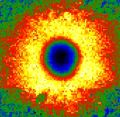Speaker
Description
The ongoing intensive research in the field of electrical discharges in or with water is fueled both by the many unsolved problems concerning the mechanism of such complex discharges and by the possible new applications of plasma-activated water (PAW) related to water decontamination and environmentally friendly synthesis of fertilizers in plasma-assisted agriculture. A nanosecond DBD-like discharge in a coplanar electrode configuration propagating along the water-air interface is an efficient source of reactive species to produce PAW. In this study, we have investigated the nitrogen fixation yields and biocidal efficiency of PAW generated in our recently developed DBD-like discharge inside a flow-through reactor with geometries analogous to a surface coplanar DBD electrode system where multiple filamentary discharges are generated and expand along the surface of a thin water layer maximizing the residence time of plasma products near the water surface. UV-vis-NIR ICCD spectroscopy was combined with electrical characteristics to determine the basic characteristics of the DBD microfilaments, including vibrational distributions and rotational temperatures of nitrogen excited states, the presence of various radicals, and time-resolved analysis of discharge phases. The efficiency in terms of $\mathrm{H_2O_2}$/$\mathrm{NO_2^-}$/$\mathrm{NO_3^-}$ production yield was determined in a flow-through reactor under well-defined and stable discharge conditions, where Fourier-transform infrared spectroscopy was used to determine the composition of outlet gas ($\mathrm{O_3}$, $\mathrm{N_2O}$, $\mathrm{NO_2}$), ion chromatography was used to analyze the generated PAW and antimicrobial activity of PAW was evaluated for Botrytis cinerea, Penicillium italicum, and Aspergillus carbonarius. The reactor operated under two discharge regimes depending on the water conductivity with the energy efficiency of NO2- and NO3- synthesis as high as 14 and 10 mmol/kJ, respectively. The inhibition rate of P. italicum subjected to PAW reached nearly 40% with B. cinerea and A. carbonarius inhibition rates being significantly smaller, however, at only 14.6% and 5.1%, respectively.

